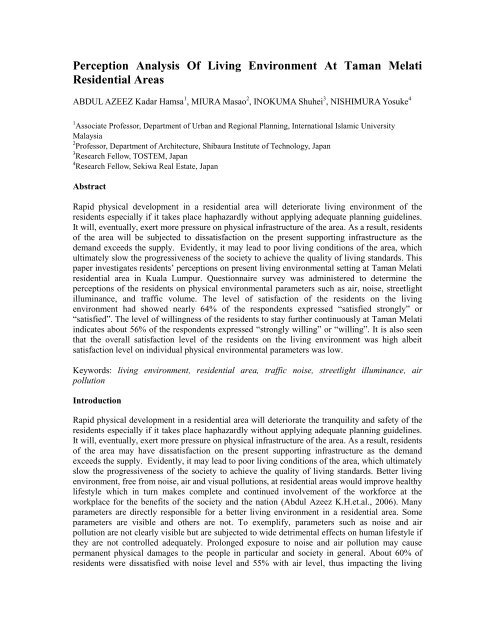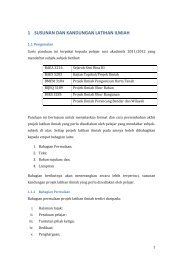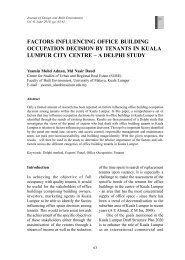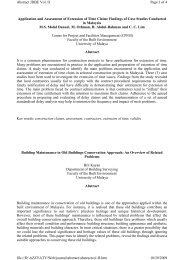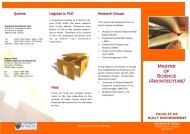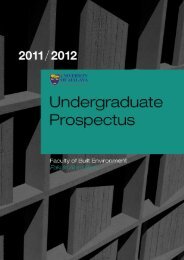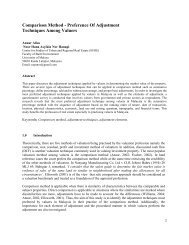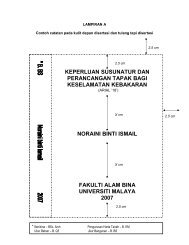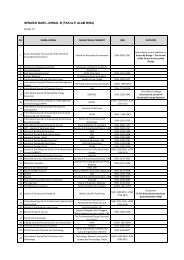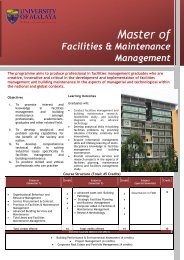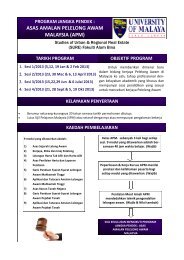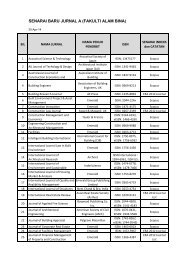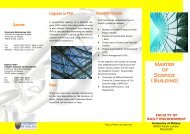Perception analysis of living environment at Taman Melati ...
Perception analysis of living environment at Taman Melati ...
Perception analysis of living environment at Taman Melati ...
Create successful ePaper yourself
Turn your PDF publications into a flip-book with our unique Google optimized e-Paper software.
NNSELANGORTAMANMELATINOT TO SCALETAMAN MELATIFigure MELA 1. Key Plan <strong>of</strong> the Study AreaTIRailway St<strong>at</strong>ionTAMAN MELATINOT TO SCALEFigure 2 Loc<strong>at</strong>ion Plan <strong>of</strong> the Study AreaArterial Road (MRR2)Jalan 8/5ParkingApartment BlocksOpen SpacePersiaran PertahananJalan 2/5<strong>Taman</strong> Mel<strong>at</strong>i 7Terrace HousesQuestionnaire SurveyFigure 3 Site Plan <strong>of</strong> the Study Area (<strong>Taman</strong> Mel<strong>at</strong>i)A questionnaire survey about the perceptions <strong>of</strong> the residents on <strong>living</strong> <strong>environment</strong> wasadministered <strong>at</strong> the selected households in the study area. The questions include awareness onnoise, air pollution, traffic volume, streetlight illuminance toward safe, healthy and comfortable<strong>living</strong> conditions <strong>of</strong> the residents, resident’s expect<strong>at</strong>ion on the physical <strong>environment</strong>al
Figure 4 Percentage <strong>of</strong> collected and uncollected questionnairesInterview(N=325)Left Quest.(N=75)Total(N=400)0 20 40 60 80 100Figure 5 Mode <strong>of</strong> administr<strong>at</strong>ion <strong>of</strong> questionnaireTerrace house(N=113)Apartment house(A-D)(N=180)Apartment house(32-42)(N=107)Total(N=400)0 20 40 60 80 100R<strong>at</strong>io(%)Figure 6 Distribution <strong>of</strong> questionnaire according totype <strong>of</strong> residencesFemale55%Male42%Unknown3%Figure 7 Frequency distribution <strong>of</strong> therespondents by gender (N = 265)70years old or more60-69 years old50-59 years old40-49 years old30-39 years old20-29 years old10-19 years oldUnknownAve:33years old0 5 10 15 20 25 30 35 40R<strong>at</strong>io(%) N=265Figure 8 Frequency distribution <strong>of</strong> therespondents by ageMalayChineseIndianOthersUnknown0 20 40 60 80 100R<strong>at</strong>io(%) N=265Figure 9 Frequency distribution <strong>of</strong> therespondents by race9 Persons8 Persons7 Persons6 Persons5 Persons4 Persons3 Persons2 Persons1 PersonUnknownAve:5persons0 5 10 15 20 25R<strong>at</strong>io(%) N=265Figure 10 Frequency distribution <strong>of</strong> household size
showed about 49% <strong>of</strong> Figure the residents 15 Residents’ had expressed expect<strong>at</strong>ion th<strong>at</strong> lack toward <strong>of</strong> ap<strong>at</strong>hy facilities by the and residents services in disposinggarbage <strong>at</strong> the design<strong>at</strong>ed storage area and 39% <strong>of</strong> the respondents were expected to see“Decrease <strong>of</strong> garbage dumping on the road side” (Suto, A. et.al., 2003). Photo 3 showsinterviewer posing questions to one <strong>of</strong> the residents <strong>at</strong> <strong>Taman</strong> Mel<strong>at</strong>i.CONCLUSIONSPhoto 3: Resident and InterviewerHealthy, harmonious, pleasant and safe <strong>living</strong> <strong>environment</strong> in a residential area are consideredbasic requirements for well being <strong>of</strong> a community. It will, eventually, provide strong bindingrel<strong>at</strong>ionship between members <strong>of</strong> the community. Moreover, it will encourage effectiveinvolvement <strong>of</strong> the working popul<strong>at</strong>ion to further develop economy <strong>of</strong> the n<strong>at</strong>ion. It also reducespublic healthcare expenditures significantly which normally found to take bigger proportion <strong>of</strong>the n<strong>at</strong>ional budget. Moreover, it enhances the visual quality <strong>of</strong> the area. The findings <strong>of</strong> thisstudy are expected to inculc<strong>at</strong>e general awareness on the existing conditions <strong>of</strong> the physical<strong>environment</strong>al parameters by the residents <strong>of</strong> the study area.The findings showed th<strong>at</strong> residents <strong>of</strong> <strong>Taman</strong> Mel<strong>at</strong>i had expressed low level <strong>of</strong> s<strong>at</strong>isfaction oneach <strong>of</strong> the physical <strong>environment</strong>al parameters such as noise, especially traffic noise, surroundingair level, and streetlight illuminance <strong>at</strong> night (Appendix). It is evident th<strong>at</strong> generally trafficvolume on many urban roads including residential neighborhood has been increasing because <strong>of</strong>the increased number <strong>of</strong> registered vehicles every year. The average hourly traffic volume alongarterial road (MRR2) near <strong>Taman</strong> Mel<strong>at</strong>i was 7800 vehicles per hour, collector road (PersiaranPertahanan, T. Mel<strong>at</strong>i) 1300 vehicles per hour and local road (Jalan 2/5, 8/5, T. Mel<strong>at</strong>i) 500vehicles per hour in 2003 (Abdul Azeez et.al, 2004, Mabeshima, D. et.al., 2003). The level <strong>of</strong> carownership in Kuala Lumpur had increased from 616 per 1000 people in 1995 to 986 to 1000people (almost one to one r<strong>at</strong>io) in the year 2000 (Eighth Malaysia Plan, 2000-2005). The number<strong>of</strong> motorcycles on many urban roads has also been increasing rapidly and it is one <strong>of</strong> the majorcontributing factors toward increased noise level <strong>at</strong> many residential neighborhoods in KualaLumpur. The increasing traffic volume also directly contributes to increase <strong>of</strong> carbon monoxide,NO 2 and other vehicle-rel<strong>at</strong>ed pollutants into the <strong>at</strong>mosphere and thus increasing level <strong>of</strong> airpollution. To exemplify, the NO 2 concentr<strong>at</strong>ion <strong>at</strong> <strong>Taman</strong> Mel<strong>at</strong>i was measured ranging between
0.01 ppm and 0.04 ppm (Abdul Azeez et.al, 2004, Mabeshima, D. et.al., 2003) with 0.02 ppm asthe acceptable level <strong>of</strong> NO 2 according to the Malaysian air quality standard. Measurement on thestreetlight illuminance showed th<strong>at</strong>, generally, the brightness level was low. The illuminance nearthe streetlights was high, and between streetlights was low. At few places, streetlights wereblocked by trees and hence, the selected road was not properly illumin<strong>at</strong>ed and <strong>at</strong> other placesthey were turned–<strong>of</strong>f. More than 50% <strong>of</strong> the streetlights along Jalan <strong>Taman</strong> Mel<strong>at</strong>i 7 hadilluminance <strong>of</strong> 3lx or less (very dark spots) (Abdul Azeez et.al, 2004) (average horizontal planeilluminance should be 3lx according to streetlight standard for the pedestrian in Japan, JIS). Poorillumin<strong>at</strong>ion <strong>of</strong> streetlights contributes to detrimental effects on the safety <strong>of</strong> residents <strong>at</strong> night asit may lead to crime and rel<strong>at</strong>ed activities.It is seen th<strong>at</strong> the overall s<strong>at</strong>isfaction level <strong>of</strong> the residents on the <strong>living</strong> <strong>environment</strong> was highalbeit s<strong>at</strong>isfaction level on individual physical <strong>environment</strong>al parameters was low. Evidently, theresidents showed gre<strong>at</strong>er inclin<strong>at</strong>ion to continue stay <strong>at</strong> <strong>Taman</strong> Mel<strong>at</strong>i (more than 50% <strong>of</strong> therespondents). It draws how important th<strong>at</strong> the residents felt to continue staying <strong>at</strong> <strong>Taman</strong> Mel<strong>at</strong>idespite low s<strong>at</strong>isfaction level on the individual physical <strong>environment</strong>al parameters. Improvingphysical <strong>environment</strong>al parameters to an acceptable standard level would definitely help residentsto live in a healthy, harmonious and safe <strong>environment</strong>al setting for the betterment <strong>of</strong> the societyand n<strong>at</strong>ion <strong>at</strong> large.REFERENCES1. Abdul Azeez, K.H., Masao Miura, Shuhei Inokuma and Yosuke Nishimura (2006)Evalu<strong>at</strong>ing the <strong>living</strong> <strong>environment</strong> in residential areas <strong>at</strong> <strong>Taman</strong> Mel<strong>at</strong>i, Kuala Lumpur,Journal <strong>of</strong> Asian Architecture and Building Engineering, Vol. 5, No.2, pp. 377-384.2. Abdul Azeez, K.H., Masao Miura, Shuhei Inokuma and Yosuke Nishimura (2004)Unpublished Report on Living Environment <strong>at</strong> <strong>Taman</strong> Mel<strong>at</strong>i, Kuala Lumpur.3. City Hall Kuala Lumpur (2003) Draft Structure Plan Kuala Lumpur 2020, Kuala Lumpur.4. Government <strong>of</strong> Malaysia (2000) Popul<strong>at</strong>ion Census Report 2000, Department <strong>of</strong> St<strong>at</strong>istics,Malaysia.5. Ker, L.T. (1991) Improving the Living Environment <strong>of</strong> Singapore, Environmental Monitoringand Assessment, Vol. 9, Issue 1-3, pp. 251-259.6. Khoo Hooi Ling (2002) Air and Noise Pollution Analysis <strong>at</strong> Highway in Malaysia, MalaysianUniversities Transport Research Forum Conference 2002, University <strong>of</strong> Malaya.7. Mabeshima, D., Inokuma, S., Nishimura, Y., Miura, M. and Abdul Azeez, K.H., (2003) A fieldsurvey for Improvement <strong>of</strong> <strong>living</strong> <strong>environment</strong> in residential area in Kuala Lumpur city Part 1 (inJapanese), Proceedings <strong>of</strong> the summaries <strong>of</strong> technical papers <strong>of</strong> the annual meeting <strong>of</strong>Architectural Institute <strong>of</strong> Japan, Hokkaido, Japan.8. Sumiani Yus<strong>of</strong>f, Asila Ishak and Khoo Hooi Ling (2002) Assessment <strong>of</strong> Environmental NoisePollution from Urban Highway, Malaysian Universities Transport Research Forum Conference2002, University <strong>of</strong> Malaya.9. Suto, A., Nishimura, Y., Inokuma, S., Miura, M. and Abdul Azeez, K.H., (2003) A field survey
“The residents have a very good neighborhood spirits and <strong>at</strong>titude <strong>of</strong> interactions. Peaceful andconveniences are guaranteed only the youth are involved in the crime. However, l<strong>at</strong>ely, it has beendecreased from time to time.”


